Above: Questa abuts the wildlands of the Rio Grande del Norte National Monument. Photographs by Minesh Bacrania.
THE VILLAGE OF QUESTA perches where the Sangre de Cristo peaks and ponderosa pine trees run out to the Taos Plateau’s high grasslands, just before they break into the dueling, black-walled basalt canyons of the Red River as it joins the Río Grande. Drive half an hour east from town and you’ll pass through tawny canyons cut by a river that borrows from the rocky palette and runs like a stream of butterscotch in the spring, heading toward alpine wilderness and the northernmost portion of the Enchanted Circle. Head west and you’re aimed at some of the first designated national wild and scenic rivers, protected by Congress half a century ago, as well as one of the most recently created national monuments, Río Grande del Norte National Monument. When he declared it as such in 2013, then-President Barack Obama described it as a “landscape of extreme beauty and daunting harshness.”
It’s easy to miss this community of 1,750, with its small, sun-faded downtown and adobe homes scattered across the valley, but locals are making Questa much more than the spot where passersby take a hard right to Red River.
“We’re very secluded. People have not found out who we are yet,” says Questa Mayor Mark Gallegos. “You’ve got to stumble on Questa.”
That’s partially because of Questa’s history. For a century, the town revolved around a single purpose: digging molybdenum from the earth. Then, in 2014, the mine closed. That necessitated a massive environmental cleanup. As part of the deal, the mine’s owner, Chevron, settled with the state of New Mexico to help the village rebound from lost business. They granted $320,000 annually for eight years, a third of which supports economic development opportunities.
Read more: Trek through a village’s history.
“Anything other than mining, to us, is new,” says Gallegos, who is also a Taos County commissioner. “When you’re here, you could be, in two minutes, up in the mountains, looking for elk sheds, or fishing. We really haven’t tapped into that kind of job possibility, but that’s what we want to focus on.”
As residents rethink Questa, they’re taking stock of the wealth of natural assets they already have. Like the stunning scenery in the Latir Peak and Columbine Hondo Wilderness Areas, the Río Grande del Norte National Monument’s dramatic canyons, clusters of picnicking families and kids with fishing poles ringing Eagle Rock Lake, a maze of off-road vehicle trails, and two ski areas within an hour’s drive. There’s also a historic adobe church, freshly restored by hand, with wooden beams and stained-glass windows, plus a gallery’s worth of artists’ studios tucked among the pines.
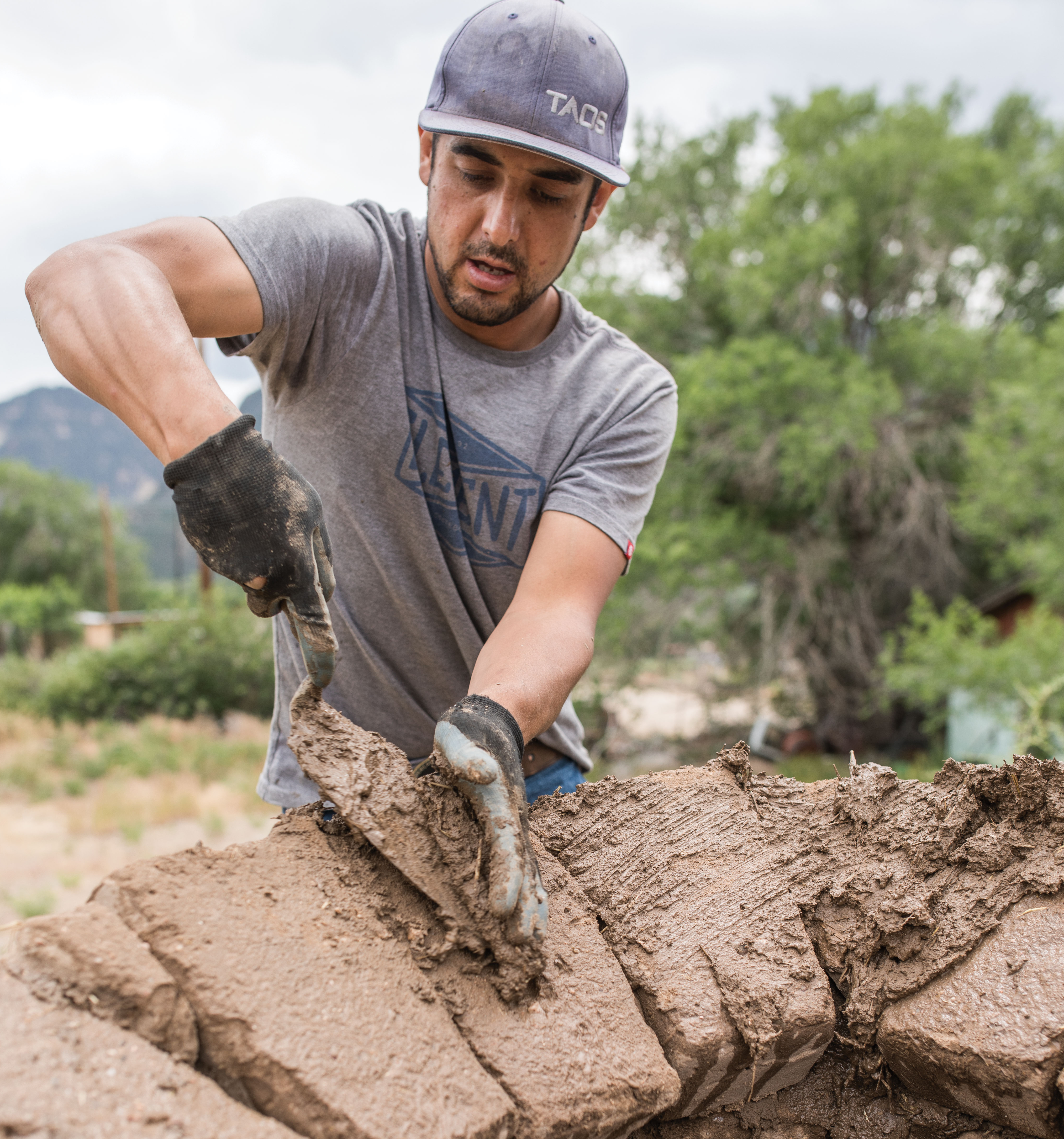 Above: Volunteer Miguel Gonzales helps build Questa's Farmers' Market horno.
Above: Volunteer Miguel Gonzales helps build Questa's Farmers' Market horno.
Small towns across the West have struggled after losing major industries that were once cornerstones of local economies and watched their populations shrink. Families can fragment and traditions evaporate as people move elsewhere in pursuit of opportunity. Questa is a close-knit, culturally rich community where legacy Hispanic families live near homesteads their ancestors settled centuries ago. A spark from the arts, outdoor recreation, or local food could breathe new life into the historic town. If they’ve learned from the crashes that follow single-industry dependence, they also know there’s no silver-bullet solution.
The challenge for Questa and mountain towns like it is to evolve without losing their core identity. Can a mining town become a fishing town, or a farming community become an artists’ enclave, without losing itself in the process? As much as Questeños hope for innovation and change—new people to bring new business and inspire entrepreneurship—they also want nothing to change. Questa should stay Questa.
FOR THREE GENERATIONS OF PEOPLE who grew up in Questa, you had few career choices. Chief among them was to work at the molybdenum mine, which employed 600 people at its peak. But in 2014, the mine closed and unemployment spiked.
“The families here had never had to think about ‘What is my kid going to do after high school?’ They went straight to the mine,” says Lindsay Mapes, director of the Questa Economic Development Fund. “And they had a lot of pride in the mine. When that doesn’t happen, there’s this sense of ‘What am I going to do with myself?’”
Molybdenum hardens steel and is used in electrodes and electrical filaments, nuclear power, and refined petroleum. There’s not less of a market for it, just more places where it is cheaper to produce. The closure left behind a Superfund site. The pile of waste rock makes for a massive, sandy heap of burnt sienna, beige, and gray that’s unmistakable from NM 38 near Red River. In 2016, the Department of Justice mandated that Chevron spend $143 million to address groundwater contamination and cover 275 acres of bare dirt and rock. By the time the Environmental Protection Agency’s recovery is complete, the scars of the open-pit mine should be made green again.
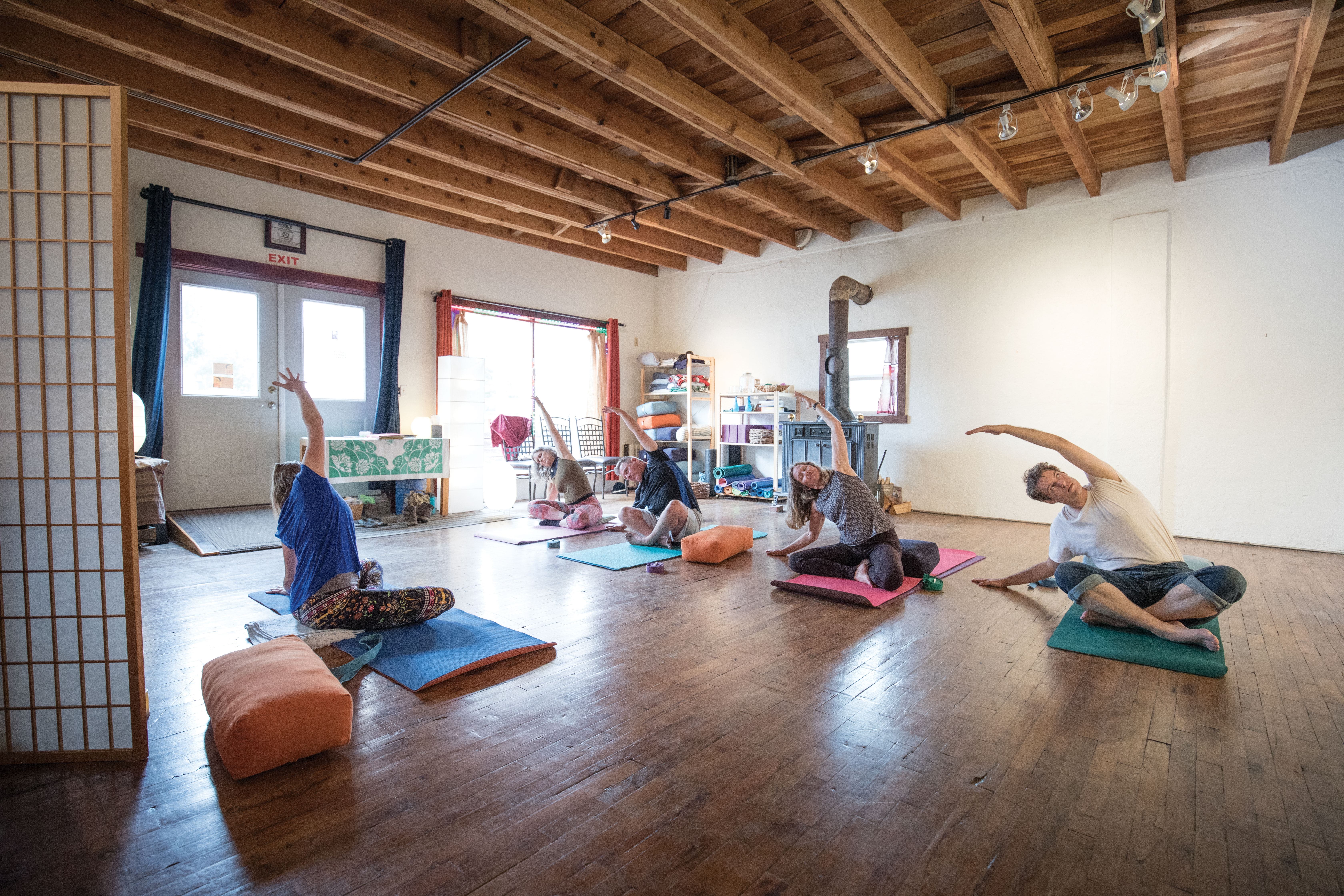 Above: Gaea McGahee teaches a yoga class at La Sala.
Above: Gaea McGahee teaches a yoga class at La Sala.
As Questa rebuilds, the town is diversifying, encouraging entrepreneurship, and touting high-speed internet that could make it a destination for remote employees, Gallegos says. New businesses have sprung up: Art Questa Gallery; Happy Paws dog kennel; La Sala yoga studio; and Río Grande del Norte Outfitters, a fly-fishing guide service. A state-run office that gives small-business advice has been so busy, Mapes says, that it doubled its office hours (from one day a month to two—it’s still a small town). Questa also managed to lure Taos Bakes (formerly Taos Mountain Energy Bar) to relocate from Taos. The company has since doubled its staff and become the first tenant in a recently constructed business park.
Existing businesses are shifting their approaches, too. Rael’s Market, a historic mercantile that supplied farmers and miners with groceries, is turning into the town coffee shop. Shelves are stocked with piñon coffee, Taos Bakes energy bars, Taos honey, beef jerky, and, usefully, bug spray. But now, an espresso machine faces a pair of couches. The store manager rises from reading the newspaper at what was once her grandmother’s kitchen table to bring the machine humming to action. Black-and-white photos on the wall show the storefront for Rael’s from nearly a century ago: a close match to what you see when you step out the front door.
“Business owners here are unique,” Gallegos says. “They are the dishwasher. They are the janitor. They hardly get the chance to explore growth, because they’ve got their head in the weeds the whole time just trying to keep the door open.”
Gallegos hopes to see the bar he runs, El Monte Carlo, mature into a “supper club” where families come for dinner. As it is, the bar permits only 21-and-over patrons. A half-dozen booths line the wall near a wooden dance floor and small stage that’s booked on holiday weekends, and a jukebox for when it’s not. Even the bartender who pops the doors open on Saturdays and Sundays has ideas for how to draw more people in, like adding a house band.
The Río Grande del Norte National Monument designation has drawn new visitors, fueling the notion of outdoor recreation as a business driver. The road that loops through the monument starts just north of town, and dirt trails zigzag from the rim to the river. Some are so steep they require staircases or ladders. On the other side of town, a string of campgrounds climbs into the nearby Carson National Forest, tent sites shaded by ponderosa pines and within earshot of the rustling Red River.
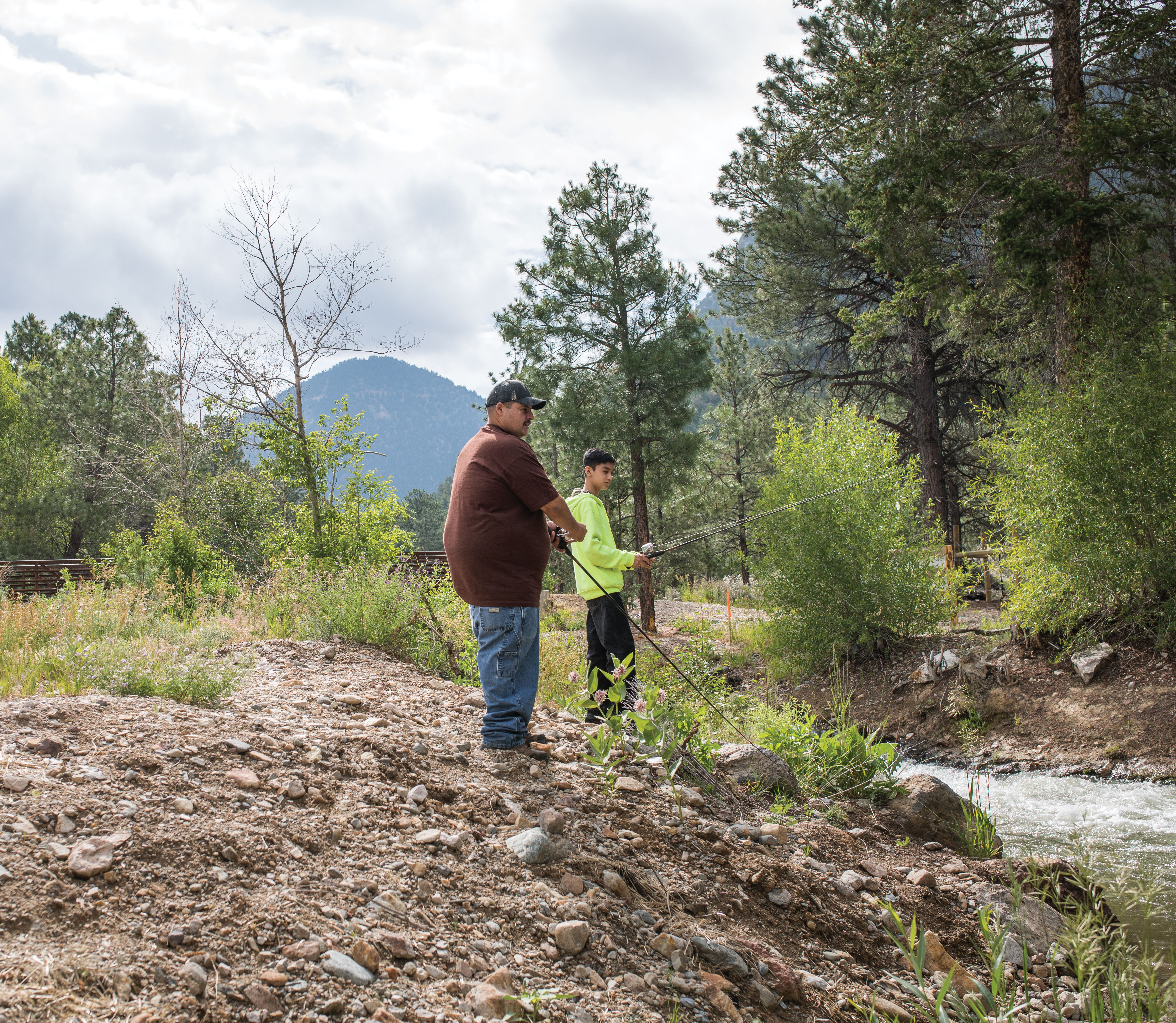 Above: Fishermen enjoy the outdoors.
Above: Fishermen enjoy the outdoors.
A new project aims to carve a trail from Questa to the town of Red River, 12 miles upstream, and draw some of that town’s many visitors to a new destination. A coalition has laid groundwork along the highway, through a stretch often crowded by bighorn sheep nibbling on grass, where a pipeline once ran tailings from the mine to holding ponds west of town. Its rusted casings are empty now. Carson National Forest staff, representatives from nonprofits Trout Unlimited and Amigos Bravos, plus Enchanted Circle Trail Association members, village staff, and Chevron employees are eyeing that level grade to convert the area to a riverside path. The route could connect the new Questa History Trail to the river and then to the peaks. Hikers, bikers, and off-road vehicles—a crew so robust in Red River that the town permits them to drive on its streets—might then pop over to Questa for lunch.
With permits and funding still to secure, the dream of a trail is still just that, but its advocates have been filing grant applications and initiating environmental reviews. Enchanted Circle Trail Association members are sketching a route for it by hiking the hillsides. The trail could also access the Red River and its once prime fly-fishing waters. Spills and sediment runoff from the mine destroyed water quality, but restoration projects, funded in part by Chevron, have helped. Endangered Río Grande cutthroat trout are reappearing close to where the Red River flows into the Río Grande. The goal is to entice outdoor enthusiasts to linger for a weekend, or just stay for lunch at the 25-year-old Wildcat Den, which attracts a steady stream of Questeños with its burgers, fries, and shakes at prices as vintage as the aluminum Coca-Cola advertisement and James Dean portrait pinned to the wall.
THE QUESTA FARMERS’ MARKET, held midday on summer Sundays, compels a rare feat: It gets tourists to stop. Gaea McGahee, a Las Cruces native who moved north for its landscape and fell in love with Questa, started the market in 2016. She used grant funding to beautify a space next to the visitor center to host it and is constructing an horno, a shade structure, and tables—and perhaps add an antique pickup with a bed full of blooming sunflowers.
Cerro Vista Farm and Walking Bear Farm supply produce, while other vendors arrive with homemade tortillas, tamales, chokecherry jelly, and eggs. Even home gardeners with a bumper crop of corn, grapes, or apples have dropped by with their abundance. Each week, McGahee hires a musician, which she paid for last year with a $1,500 microgrant from Chevron. These folks were all already raising chickens, sewing aprons, and baking tortillas before the market came into being, she says. They just didn’t know about one another.
“Until we have a space where the commons are alive again, a place where we can all see each other, we don’t even know what we have,” McGahee says. “If everyone here now, doing what they’re doing, can collaborate, that’s the genius of how we can do economic recovery.”
To further support small-scale food producers and other entrepreneurs, she purchased a former filling station and began gutting and remodeling it. She named it La Sala, which enjoys dual meanings: Sanskrit for a sheltering tree and Spanish for a living room. Ultimately, she says, the space is meant to grow into whatever the community needs it to be that fits a mission of increasing physical, mental, and economic health. In April, with work still under way to insulate the floors and clean off the dirt roof, it was becoming a yoga studio, a co-working space, a commercial kitchen, a venue for chamber music concerts and a Día de los Muertos celebration, and a spot where a local musician can park a piano to offer lessons. People in Questa seem to wear a lot of hats, McGahee says, and La Sala could host meetings or just offer a spot to flip open a laptop.
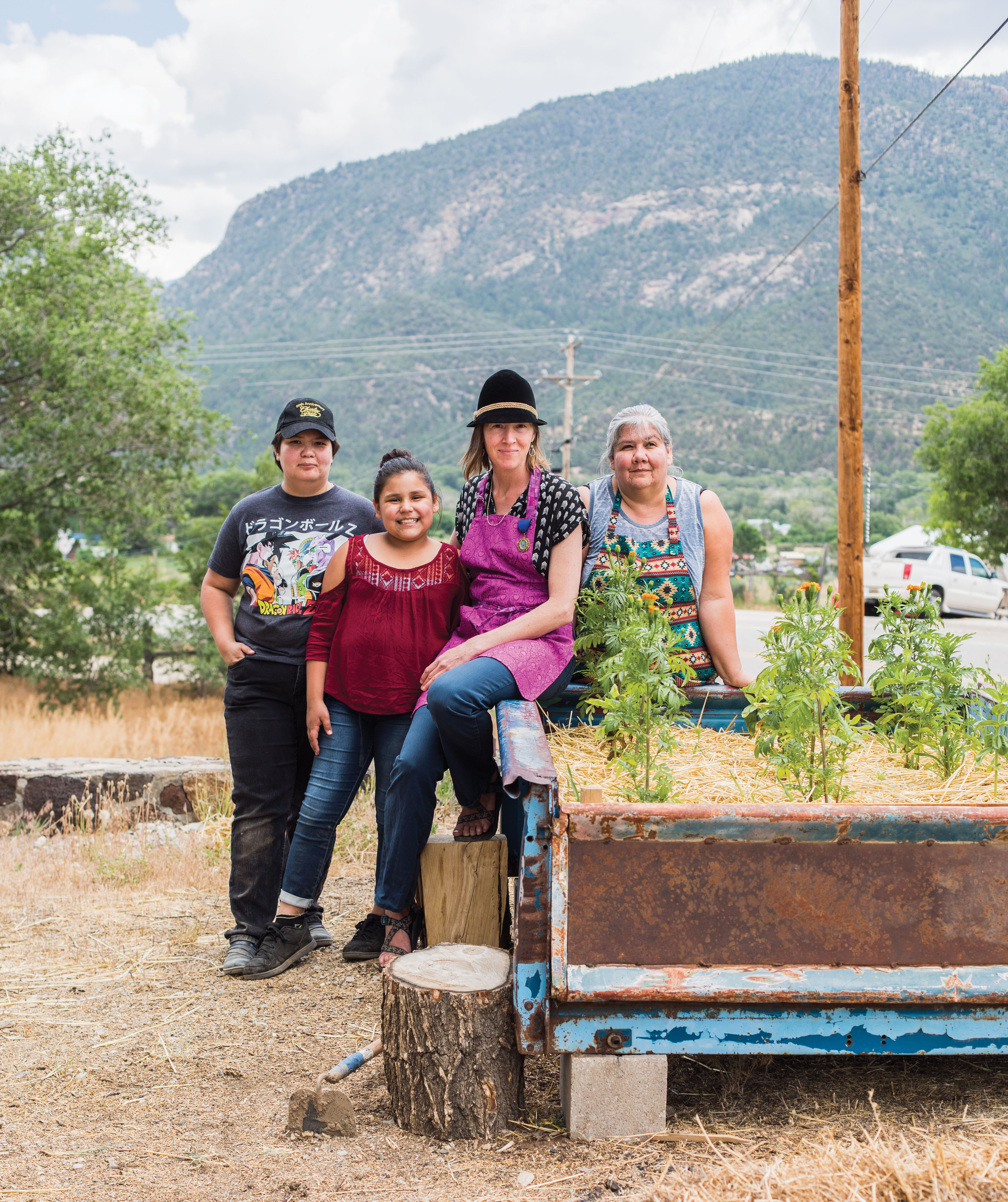
Above: Alex Romero, Jayden Harding, Gaea McGahee and Wendy Medina at the farmers' market.
“This is how I’ve found most things in Questa—you adapt to meet the needs you find as you’re doing the thing,” McGahee says. “We’re trying to make solutions. That’s what the point of all this is.”
The mine closure, she notes, isn’t the town’s only problem. Addictions, fractured families, and other historical traumas play a role.
“I understand that people had jobs when this mine opened up and boomed, but I think people kind of lost their way,” Flavio Cisneros, a lifelong resident, says in Questa Stories, an oral history project. “They forsook their land and concentrated on having a job with the mine. The mine became the end-all for everything.”
When he taught history at the high school, Cisneros heard about graduates unable to read and write well enough to complete a job application at the mine. He pushed kids to learn, only to hear them retort that they didn’t need an education to be a miner and earn a salary that topped his.
“I resented that, and I resent that yet, because the mine was not the answer,” he says. “I always said the mine is not a forever thing. One of these days, the mine is going to collapse, and what are you going to do? Because you will not be prepared to accept the challenges that come when there is no mine.”
CAMPGROUNDS IN THE RÍO GRANDE DEL NORTE MONUMENT overlook the river from a perch so high that the water seems just an emerald ribbon in the belly of a dark canyon. Each fall, the NeoRio arts festival draws artists and musicians here. Claire Cote, a Questa native, founded both the festival and its parent organization, LEAP (Land, Experience and Art of Place), a decade ago. Over the years, sculptors have crafted pieces intended for a primary audience of animals, stenciled local stories onto pavement near the visitor center with pigments sourced from the landscape, and installed fiber arts designed to dissolve into the desert over time.
“I’ve always been interested in that relationship between local culture and how the visitor brings a fresh perspective and a fresh eye, so I like to really welcome and create an unusual venue for artists to be able to experiment,” she says.
The event is a cornerstone on the Questa Creative Council’s calendar. The council was founded in 2017 to solidify the local community by firming up connections among local artists. Cofounder Peggy Trigg says their work often starts with persuading local woodworkers, potters, glassblowers, painters, welders, leatherworkers, and soapmakers to define what they do as art. The Art Questa Gallery welcomes “burl bowls” made of the rounded knots that form in tree trunks, as well as antler chandeliers and cigar-box guitars.
The council also hopes to draw visitors who might make their stay permanent. In 2018, the council counted 950 participants at events that included workshops, chamber music concerts, and a plein air painting festival. More than half of the attendees were from out of town. Once people see the beauty, the rich history and culture, the community vibrancy, the lure is set, says cofounder Roger Harrington. He and Trigg both transplanted from other locations to live among the mountains they once visited to paint.
Since the mine closed, Cote says, Questa has seen “an upsurge of creativity and a kind of commitment to community. It seems like the momentum has just started. There’s sort of a realization that visitors are not necessarily a fully welcome thing, but they’re more embraced now, because it’s part of the need to embrace tourism as one of the ways to diversify economic development.”
An adobe school once slated for demolition has been waiting for this kind of energy. La Ciénega, built by the Works Progress Administration, is set for a rebirth as a multipurpose community center, with an auditorium for local plays, a senior center, a teen center, a business incubator, and art studios. Its windows and white-painted corbels look out over a parking lot pocked with elm saplings and chamisa bushes, rusted swing-set frames, and hoopless basketball backboards. Uphill, a brown scar mars the Sangres, where the shoulder of the mine overlooks the town.
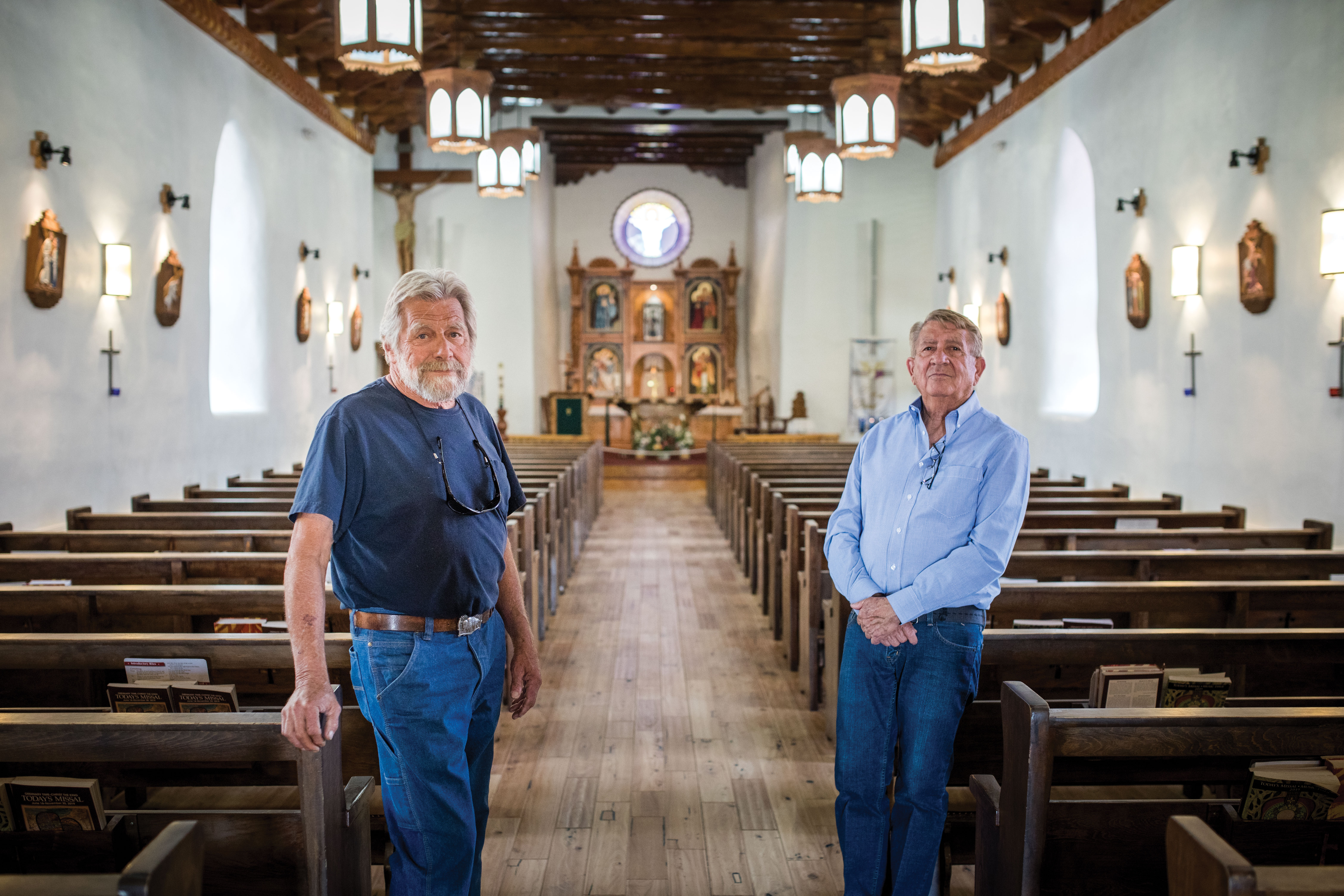 Above: Mark Sideris (left) and Flavio Cisneros led the restoration of St. Anthony's church.
Above: Mark Sideris (left) and Flavio Cisneros led the restoration of St. Anthony's church.
Questeños have a knack for rising to rescue these pieces of the past, says Gallegos, the mayor. That’s perhaps best demonstrated in St. Anthony’s church. The historic structure had been so neglected that, in 2008, one of its walls collapsed. The Archdiocese of Santa Fe ordered its demolition. But volunteers ran raffles and held dances to save it. They sold memorial adobes from the original building and handmade quilts. Woodworkers, carpenters, and even a stained-glass artist emerged to help. In 2016, the renovated church was re-consecrated. It’s a pilgrimage site for the faithful—and for painters who capture it before a backdrop of peaks as part of the Creative Council’s Wild Rivers Plein Air Festival.
“The church kind of gave us that tenacity that we needed,” Gallegos says. It was a reminder, he says, of how to change: “Everybody, as a community, works together to make things different.”

QUEST FOR ADVENTURE
Visit the Art Questa Gallery, especially during the Questa Studio Arts Tour, August 17–18, NeoRio, on September 21, and the Wild Rivers Plein Air Festival, in July. Chamber music concerts pop up on the calendar as well (questacreative.org).
Browse the Questa Farmers’ Market and enjoy live music on Sundays, 10 a.m. to 2 p.m., from mid-June to mid-September.
A new trail race invites runners to “Pick Your Poison” on October 13, with 5K and 10K options on the Big Arsenic and Little Arsenic trails, in the Río Grande del Norte National Monument.
Book a local fishing guide through the Taos Fly Shop or Río Grande del Norte Outfitters.
Take a yoga class or attend the Día de los Muertos event at La Sala.
Admire the stained glass and a view of the Sangre de Cristos from St. Anthony’s church, on the historic plaza.
Walk the Questa History Trail, a self-guided 0.6-mile loop from the old church plaza that includes historical and cultural viewpoints (questatrail.org). To learn more, see “Hero’s Questa,” June 2019 (nmmag.us/qtrail).
COMING ATTRACTIONS: Hike, bike, or drive an off-road vehicle from Questa to Red River on an under-development trail through the Carson National Forest.
Check on the renovation of the community center at the old La Ciénega school site.
Take pride in the U.S. Capitol Christmas Tree, along with trees for other federal offices, which will travel to Washington, D.C., from the Questa District of the Carson National Forest.


